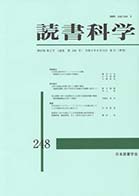Volume 63, Issue 2
Displaying 1-9 of 9 articles from this issue
- |<
- <
- 1
- >
- >|
-
2022Volume 63Issue 2 Pages cover1-
Published: June 13, 2022
Released on J-STAGE: July 02, 2022
Download PDF (9257K) -
2022Volume 63Issue 2 Pages TOB1-
Published: June 13, 2022
Released on J-STAGE: July 02, 2022
Download PDF (8960K)
Original Articles
-
2022Volume 63Issue 2 Pages 53-63
Published: June 13, 2022
Released on J-STAGE: July 02, 2022
Download PDF (679K)
Study Report
-
2022Volume 63Issue 2 Pages 64-75
Published: June 13, 2022
Released on J-STAGE: July 02, 2022
Download PDF (2194K) -
2022Volume 63Issue 2 Pages 76-88
Published: June 13, 2022
Released on J-STAGE: July 02, 2022
Download PDF (673K)
Research Review
-
2022Volume 63Issue 2 Pages 89-100
Published: June 13, 2022
Released on J-STAGE: July 02, 2022
Download PDF (761K) -
2022Volume 63Issue 2 Pages 101-110
Published: June 13, 2022
Released on J-STAGE: July 02, 2022
Download PDF (718K)
-
2022Volume 63Issue 2 Pages Regulation-
Published: June 13, 2022
Released on J-STAGE: July 02, 2022
Download PDF (10493K) -
2022Volume 63Issue 2 Pages Colophon1-
Published: June 13, 2022
Released on J-STAGE: July 02, 2022
Download PDF (10038K)
- |<
- <
- 1
- >
- >|
